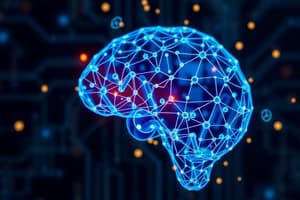Podcast
Questions and Answers
What component of a node corresponds to its physical configuration in the state space?
What component of a node corresponds to its physical configuration in the state space?
- n.STATE (correct)
- n.ACTION
- n.PATH-COST
- n.PARENT
Which of the following best describes the purpose of the n.PARENT component in a node?
Which of the following best describes the purpose of the n.PARENT component in a node?
- It represents the action taken to reach the node.
- It indicates the cost of reaching the node.
- It defines the depth of the node in the tree.
- It is the node that generated the current node. (correct)
Which operation on a queue allows you to retrieve and remove the first element?
Which operation on a queue allows you to retrieve and remove the first element?
- INSERT
- FETCH
- POP (correct)
- EMPTY?
What does the completeness of a search strategy refer to?
What does the completeness of a search strategy refer to?
In the context of search strategies, what does b represent?
In the context of search strategies, what does b represent?
Which of the following best describes what is stored in the frontier of a search algorithm?
Which of the following best describes what is stored in the frontier of a search algorithm?
What does n.PATH-COST represent in a node structure?
What does n.PATH-COST represent in a node structure?
Which of the following dimensions is NOT typically used to evaluate search strategies?
Which of the following dimensions is NOT typically used to evaluate search strategies?
What is the primary goal for the agent in Romania?
What is the primary goal for the agent in Romania?
Which of the following best describes path cost?
Which of the following best describes path cost?
What is a characteristic of toy problems?
What is a characteristic of toy problems?
What does an optimal solution refer to in the context of path cost?
What does an optimal solution refer to in the context of path cost?
In the vacuum world scenario, what does the initial state represent?
In the vacuum world scenario, what does the initial state represent?
What is abstraction in problem formulation?
What is abstraction in problem formulation?
Which action has no effect if performed in certain boundary conditions in the vacuum world?
Which action has no effect if performed in certain boundary conditions in the vacuum world?
What might be measured by the path cost function?
What might be measured by the path cost function?
Which of the following factors is NOT typically included in a state description for route planning?
Which of the following factors is NOT typically included in a state description for route planning?
How is the path cost calculated in the vacuum world?
How is the path cost calculated in the vacuum world?
What type of problem is categorized as sensorless in the context of the vacuum world?
What type of problem is categorized as sensorless in the context of the vacuum world?
How is the step cost represented in the context of reaching a goal?
How is the step cost represented in the context of reaching a goal?
Which characteristic of step costs is emphasized in the context presented?
Which characteristic of step costs is emphasized in the context presented?
What defines a contingency problem?
What defines a contingency problem?
In the vacuum world with multiple locations, how many states are there if n = 3?
In the vacuum world with multiple locations, how many states are there if n = 3?
What is the expected outcome of performing the action 'Right' from the location #5 in a sensorless problem?
What is the expected outcome of performing the action 'Right' from the location #5 in a sensorless problem?
What defines a problem-solving agent?
What defines a problem-solving agent?
Which type of search algorithms lack specific information about the problem they are solving?
Which type of search algorithms lack specific information about the problem they are solving?
What is the main purpose of goal formulation in problem solving for agents?
What is the main purpose of goal formulation in problem solving for agents?
Why are informed search algorithms generally more efficient than uninformed ones?
Why are informed search algorithms generally more efficient than uninformed ones?
What can be said about the performance measure of intelligent agents?
What can be said about the performance measure of intelligent agents?
What happens to actions that do not lead an agent to its goal in a problem-solving scenario?
What happens to actions that do not lead an agent to its goal in a problem-solving scenario?
In the context of problem-solving agents, what does an agent typically focus on during problem formulation?
In the context of problem-solving agents, what does an agent typically focus on during problem formulation?
Which of the following describes a scenario where a goal-based agent could simplify its decision-making?
Which of the following describes a scenario where a goal-based agent could simplify its decision-making?
What is the time complexity of depth-first search?
What is the time complexity of depth-first search?
What advantage does depth-first search have over breadth-first search?
What advantage does depth-first search have over breadth-first search?
How does depth-limited search differ from standard depth-first search?
How does depth-limited search differ from standard depth-first search?
What is the space complexity of iterative deepening search?
What is the space complexity of iterative deepening search?
Why might iterative deepening search generate more nodes than depth-limited search?
Why might iterative deepening search generate more nodes than depth-limited search?
What is the impact of choosing a poor depth limit in depth-limited search?
What is the impact of choosing a poor depth limit in depth-limited search?
In which scenario would depth-first search be less effective?
In which scenario would depth-first search be less effective?
What is the complete nature of iterative deepening search?
What is the complete nature of iterative deepening search?
Study Notes
Problem Solving Agents
- Aim to maximize performance measure
- Can simplify by adopting a goal and aiming at satisfying it
Goal Formulation
- Helps organize behavior by limiting objectives the agent tries to achieve
- First step in problem solving
- A goal is a set of world states where its satisfied
Path Cost
- Assigns a numeric cost to each path
- Reflects agent's performance measure
- Sum of costs of individual actions along the path
- Step cost: c(s, a, s')
- Nonnegative
Optimal Solution
- Action sequence that leads from the initial state to a goal state
- Measured by path cost function
- Lowest path cost among all solutions
Formulating Problems
- Model is an abstract mathematical description of the real thing
- Abstraction is removing detail from a representation
Toy Problems: Vacuum World
- States: Agent location and dirt locations
- Actions: Left, Right, Suck
- Transition Model: Actions have their expected effects, unless the agent is at the edge or in a clean square
- Goal Test: Checks whether all squares are clean
- Path Cost: Each step costs 1
Problem Types
- Deterministic, fully observable: Solution is a single sequence
- Non-observable: Solution is a sequence
- Nondeterministic and/or partially observable: Solutions are sequences that account for new information from the environment, often interleaving search and execution
- Unknown state space: Solution requires exploration of the environment
Search Algorithms
- Strategies are evaluated based on completeness, optimality, time & space complexity
- Time complexity expresses how long it takes to find a solution
- Space complexity expresses how much memory is needed to perform the search
Depth-First Search
- Complete in finite spaces only
- Time complexity: O(bm)
- Space complexity: O(bm)
- No: Not optimal
Iterative Deepening Search
- Complete
- Time complexity: Similar to breadth-first search for shallow solutions
- Space complexity: O(bd)
- Yes: Optimal
Studying That Suits You
Use AI to generate personalized quizzes and flashcards to suit your learning preferences.
Related Documents
Description
This quiz covers the essential concepts of problem-solving agents in artificial intelligence, including goal formulation, path cost, and optimal solutions. It also discusses toy problems like the Vacuum World to illustrate these concepts. Test your understanding of how these elements work together to create intelligent behaviors.




